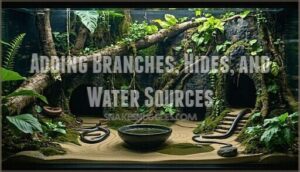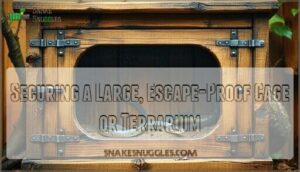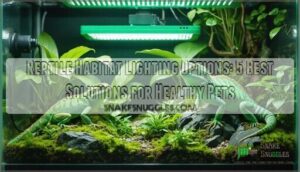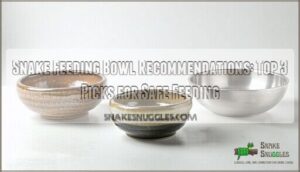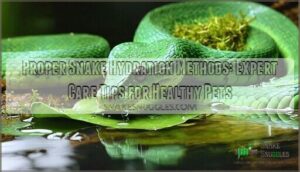This site is supported by our readers. We may earn a commission, at no cost to you, if you purchase through links.
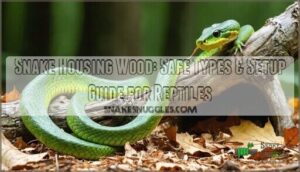 When choosing snake housing wood, you’ll want to stick with safe options like oak, maple, aspen, and apple wood. These won’t release harmful oils that can damage your snake’s respiratory system.
When choosing snake housing wood, you’ll want to stick with safe options like oak, maple, aspen, and apple wood. These won’t release harmful oils that can damage your snake’s respiratory system.
Avoid cedar, pine, and eucalyptus at all costs – they’re toxic to reptiles. You can use wood for branches, hides, and even custom enclosures, but it needs proper preparation first.
Baking or boiling natural wood kills bacteria and parasites. Commercial reptile wood products are pre-treated and ready to use.
The right wood choice creates a naturalistic environment that supports your snake’s climbing, hiding, and thermoregulation needs while keeping them healthy and stress-free.
Table Of Contents
- Key Takeaways
- Selecting Safe Wood for Snakes
- Designing and Setting Up Snake Enclosures
- Best Wooden Hides for Snakes
- Preparing Natural Wood for Reptiles
- Frequently Asked Questions (FAQs)
- How to make wood safe for snake enclosure?
- What is the best material for a snake enclosure?
- How to sanitize wood for snake enclosure?
- How long to bake wood for snake enclosure?
- What types of wood are toxic to snakes?
- Can I use a wooden aquarium as a snake enclosure?
- How often should I replace the wooden decorations in my snakes cage?
- Can I use wood from my backyard to build a snake enclosure?
- How often should wooden snake enclosures be cleaned?
- Can I use driftwood from beaches safely?
- Conclusion
Key Takeaways
- Choose safe hardwoods like oak, maple, and aspen – these won’t release harmful oils that damage your snake’s respiratory system like toxic cedar, pine, and eucalyptus do.
- Always sterilize natural wood before use – bake at 250°F for 2 hours or boil for 20 minutes to kill bacteria and parasites that could harm your snake.
- Create proper temperature gradients and hiding spots – use wood strategically to build basking areas (85-90°F) and cooler zones (75-80°F) with secure hideouts.
- Maintain and replace wooden elements regularly – inspect for cracks, mold, or wear every 6-12 months and clean weekly to prevent bacterial buildup.
Selecting Safe Wood for Snakes
Choosing the right wood for your snake’s home isn’t just about looks—it’s about keeping your pet healthy and safe.
Some woods like cedar and pine contain oils that can harm your snake’s breathing and skin, while safer options like oak and maple create a natural environment without the nasty side effects, making them a better choice for a natural environment.
Why Wood Safety Matters for Reptile Health
When choosing snake enclosure wood, you’re protecting your reptile from serious health risks.
Toxic woods release harmful chemicals that cause respiratory problems, skin irritation, and toxicity symptoms like lethargy or appetite loss.
Species sensitivity varies, but all snakes face long-term effects from exposure.
To guarantee safety, consider PVC for enclosures due to its durability and heat retention.
Wood treatment with proper sterilization and selecting safe alternatives guarantees your snake’s health and longevity.
Avoiding Toxic Wood Options (Cedar, Pine, Eucalyptus, Etc.)
When selecting wood for your snake’s enclosure, cedar toxicity poses serious health risks.
Cedar contains volatile aromatic oils and phenols that cause respiratory irritation and skin lesions. Pine dangers include similar phenol exposure from resin compounds. Eucalyptus risks stem from toxic aromatic oils that suppress immune function.
Skip cedar, pine, and eucalyptus completely—these toxic woods release harmful chemicals that damage your snake’s respiratory system and skin.
These toxic woods release harmful fumes even when dried. For reptile safety, it’s vital to avoid wood that has chemical contaminants.
Skip the guesswork—choose proven safe hardwoods like aspen, oak, or maple instead. Your snake’s health depends on proper wood safety choices.
Designing and Setting Up Snake Enclosures
Creating the perfect snake enclosure isn’t just about throwing together some wood and calling it home.
You’ll need to balance temperature zones, humidity levels, and species-specific needs to build a habitat that keeps your scaly friend healthy and happy.
This involves considering the species-specific needs of your snake to ensure the enclosure provides the right environment.
Creating a Temperature Gradient and Humidity Zone
Your snake needs a proper temperature gradient to thrive.
Position heating methods at one end of the enclosure, creating a warm basking spot around 85-90°F and a cooler zone at 75-80°F.
This gradient design lets your snake choose its comfort zone.
Monitor humidity levels between 40-70% using digital tools.
Precise control often requires a reliable thermostat.
Species needs vary, so research your snake’s requirements for ideal temperature control and humidity regulation.
Adding Branches, Hides, and Water Sources
Once your temperature and humidity zones are dialed in, it’s time to create your snake’s perfect hangout spot.
Branches offer climbing opportunities and enrichment benefits – place them at different heights for variety. Natural branches work great when properly prepared.
Hides provide essential hiding places – use logs, caves, or commercial options with smart hide placement throughout the enclosure.
Don’t forget a sturdy water source for drinking and soaking.
To guarantee safety, utilize escape-proof lids on the enclosure. Secure anchoring prevents dangerous shifts that could injure your snake.
These additions transform a basic enclosure into a thriving habitat.
Customizing for Snake Species-Specific Needs
When creating your snake’s perfect home, understanding species-specific requirements becomes your blueprint for success.
Desert species thrive with lower humidity levels and spacious floor plans, while tropical snakes need moisture-rich environments and vertical climbing needs.
Here’s your customization checklist:
- Humidity Control – Match your snake’s natural habitat (30-40% for desert species, 60-80% for tropical)
- Temperature Zones – Create proper temperature gradient with basking spots 5-10°F warmer than cool areas
- Enclosure Size and substrate choice – Provide adequate space and appropriate bedding for burrowing or surface-dwelling behaviors
Research your snake species thoroughly. Providing the correct heat and temperature is vital for their well-being. The right setup using safe wood types makes all the difference between a stressed snake and a thriving one.
Securing a Large, Escape-Proof Cage or Terrarium
Your snake’s safety depends on a bulletproof enclosure that won’t let your escape artist slip away.
A well-built wood snake cage needs proper planning and execution.
- Secure Latches: Install heavy-duty locks that can’t be pushed open by determined snakes
- Glass Thickness: Use thick panels that won’t crack under cage weight and pressure
- Ventilation Security: Design airflow systems that prevent escapes while maintaining fresh air
- Hiding Cords: Keep electrical components safely tucked away from curious reptiles
For enhanced security, consider investing in specialized reptile hardware.
Best Wooden Hides for Snakes
You’ll find that wooden hides create the perfect secure retreats where your snake can regulate stress and feel naturally protected.
The best wooden hide options combine durability with species-appropriate sizing to meet your pet’s instinctual need for enclosed spaces.
1. Reptile Hideout Climbing Ladder
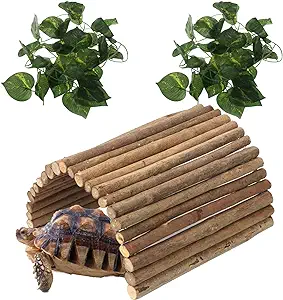
You’ll find the Reptile Hideout Climbing Ladder transforms your snake enclosure into an adventure playground.
This bendable wooden snake cage accessory uses natural wood sticks connected by flexible metal wire, creating versatile hideout integration options.
Your snake can climb, tunnel, or bridge gaps while staying secure.
| Feature | Details |
|---|---|
| Ladder Material | Natural wood sticks with metal wire |
| Ladder Safety | Flexible design prevents injury |
| Climbing Difficulty | Easy to moderate for most snakes |
| Enrichment Value | High – encourages natural behaviors |
The wood construction fits perfectly in any snake habitat wood setup.
Simply dust before installation to remove loose particles.
This hideout reduces stress while promoting exercise and exploration.
The flexible design adapts to your snake enclosure’s unique layout, whether horizontal or vertical positioning works best.
Best For: Active snakes needing mental stimulation and comfortable hiding spots in their wooden snake cage environment.
2. Reptile Hide Medium Critter Cavern
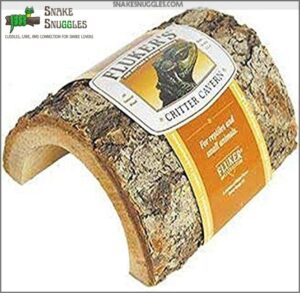
Multiple reptile habitat wood options exist, but the Medium Critter Cavern stands out for Cavern Material Safety.
This natural wooden reptile enclosure accessory offers excellent Cavern Humidity Control while providing secure hiding spots.
Cavern Size Matters for comfort—this medium option fits most snakes perfectly.
Cavern Placement Tips include positioning away from heat sources.
The Critter Cavern Benefits include natural aesthetics and durability, making it ideal snake terrarium wood décor for your reptile vivarium wood setup.
3. Zoo Med Giant Habba Hut
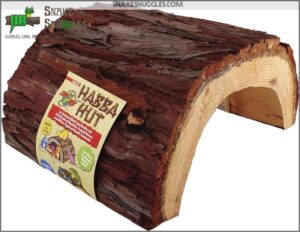
Your snake’s sanctuary deserves the Zoo Med Giant Habba Hut – a wooden snake enclosure accessory that brings natural comfort to any snake habitat.
This real wood hiding place offers authentic texture and durability that plastic alternatives can’t match.
Here’s what makes this wooden snake enclosure standout:
- Habba Hut Size – Perfect dimensions for small to medium snakes seeking cozy shelter
- Material Composition – Solid natural wood construction provides authentic habitat feel
- Snake Comfort – Curved design mimics natural hollow logs snakes love
- Cleaning Ease – Smooth interior surfaces make maintenance straightforward
The solid wood construction means your snake house will last through countless shed cycles.
You can pair it with terrarium moss for humid microclimates.
Just expect some natural wood debris – it’s normal and easily managed with regular spot-cleaning.
Alternative hides exist, but few match this authentic wood texture that makes snakes feel secure in their snake enclosure.
4. Aquarium Resin Bark Hide Cave
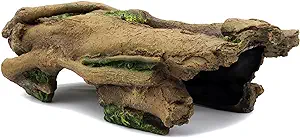
Your snake deserves a hide that combines safety with natural beauty. The Aquarium Resin Bark Hide Cave delivers both! This non-porous resin construction resists bacteria while mimicking real bark textures.
You’ll love how easy it’s to clean – just rinse and disinfect without worrying about wood rot or chemical absorption. Snakes benefit from hides that reduce stress effectively, promoting their overall well-being.
Best For: Snake owners wanting realistic cave aesthetics with maximum cave material safety.
| Feature | Benefit | Maintenance |
|---|---|---|
| Resin material | Chemical-free, non-toxic | Monthly deep clean |
| Bark texture | Natural appearance | Weekly spot cleaning |
| Non-porous surface | Prevents bacteria growth | Quick rinse after use |
| Durable construction | Long-lasting investment | No replacement needed |
| Multiple sizes | Fits various species | Size-appropriate cleaning |
The resin cave benefits include superior hide cave size options and easy cleaning resin hides maintenance. Perfect for your wooden snake terrarium setup, this reptile cage wood alternative offers snake house wood aesthetics without the risks. It’s ideal for any wood snake vivarium or snake cage diy wood project.
Preparing Natural Wood for Reptiles
Getting your natural wood ready for your snake’s home doesn’t have to be rocket science. With proper wood safety techniques, you’ll create a secure environment that keeps your reptile happy and healthy.
Here’s your step-by-step game plan:
- Wood Sourcing and Selection: Choose untreated wood like oak, maple, or ash. Skip softwoods entirely – they’re trouble waiting to happen.
- Cleaning Methods and Bark Removal: Scrub branches with hot water and remove all loose bark. Sand rough spots smooth to prevent injuries.
- Sterilization Techniques: Bake wood at 200-250°F for 1-2 hours, or soak in 10% bleach solution for 24 hours followed by thorough rinsing.
- Safe Anchoring: Once completely dry, secure branches firmly in the enclosure to prevent shifting or falling.
Remember, sterilize branches thoroughly before introducing them to your snake’s space. Providing hiding spots can also reduce stress for your snake.
This process eliminates harmful bacteria and pests while ensuring your snake safety isn’t compromised. Take your time with preparation – your snake will thank you.
Frequently Asked Questions (FAQs)
How to make wood safe for snake enclosure?
Wood preparation can be absolutely essential for your snake’s health.
You’ll need to sterilize branches by boiling them for 20 minutes or baking at 250°F for two hours, then let them dry completely, which involves complete procedures to ensure your snake’s safety.
What is the best material for a snake enclosure?
Glass and PVC enclosures dominate the market for good reason.
They’re easy to clean, maintain proper humidity, and let you watch your snake’s behavior.
Glass terrariums offer excellent visibility while PVC provides superior insulation and lighter weight for handling.
How to sanitize wood for snake enclosure?
To properly sanitize wood for your snake’s home, you’ll need to remove all harmful bacteria and parasites.
Start by baking the wood at 250°F for two hours to kill dangerous microorganisms lurking inside.
How long to bake wood for snake enclosure?
Curiously, the same heat that sterilizes also preserves wood’s natural beauty. You’ll want to bake your wood at 250°F for exactly 2 hours to eliminate harmful bacteria and parasites completely.
What types of wood are toxic to snakes?
Cedar and pine woods are toxic to snakes due to aromatic phenols and oils that cause respiratory and skin problems.
Avoid eucalyptus, fruit tree woods, and any treated lumber with chemicals or pesticides.
Can I use a wooden aquarium as a snake enclosure?
Wooden wonders work well, but you’ll want waterproof wood that’s properly prepared. Check if it’s made from safe hardwoods like oak or maple, then seal thoroughly with aquarium-safe sealant.
How often should I replace the wooden decorations in my snakes cage?
You’ll replace wooden decorations every 6-12 months or when they show signs of wear, damage, or bacterial growth.
Regularly inspect them for cracks, soft spots, or mold that could harm your snake’s health.
Can I use wood from my backyard to build a snake enclosure?
You shouldn’t use backyard wood for snake enclosures because it may contain harmful pesticides, toxins, or chemicals that could seriously harm your snake’s health and potentially prove fatal.
How often should wooden snake enclosures be cleaned?
You’ll need to spot-clean your wooden snake enclosure weekly.
This keeps bacteria at bay and prevents odors from building up in the wood grain.
You should also do a thorough deep clean monthly.
Can I use driftwood from beaches safely?
Beach driftwood isn’t safe for snake enclosures.
Salt, pollutants, and unknown chemicals make it risky. You can’t properly sterilize it to remove all contaminants.
Instead, buy commercial wood or collect from pesticide-free inland areas for your snake’s safety.
Conclusion
Back when knights used chainmail armor, they knew protection mattered – and the same goes for your snake’s habitat today.
Choosing proper snake housing wood isn’t just about looks; it’s about keeping your reptile healthy and happy.
You’ve learned which woods are safe (oak, maple, aspen) and which ones to avoid (cedar, pine, eucalyptus).
Remember to prepare natural wood properly through baking or boiling.
Your snake will thrive in a well-designed wooden environment that meets their specific needs.
- https://www.reddit.com/r/woodworking/comments/46lst5/suggested_wood_type_for_reptile_enclosure/
- https://www.aussiepythons.com/threads/what-wood-is-safe-for-snakes.164862/
- https://community.morphmarket.com/t/plywood-enclosure/30925
- https://thebarnyardsupplyco.com/housing-for-your-pet-snake/
- https://www.pbspettravel.co.uk/blog/snake-vivariums-what-are-the-options/


